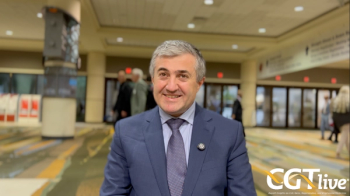
Longer Lenalidomide Maintenance for Myeloma Improved Survival After Transplant
Longer durations of maintenance therapy with lenalidomide were associated with longer survival among patients who underwent autologous hematopoietic stem cell transplant for multiple myeloma.
Longer durations of maintenance therapy with lenalidomide were associated with longer survival among patients who underwent autologous hematopoietic stem cell transplant (auto-HCT) for multiple myeloma, according to the results of a single-center retrospective study
Based on these results, Idrees Mian, MD, of the University of Texas Health Science Center at Houston, and colleagues, concluded that “conceivably the most practical approach is to continue maintenance lenalidomide until unacceptable toxicity or disease progression after auto-HCT.”
According to Mian and colleagues, this study was designed to evaluate the effect of the duration of maintenance lenalidomide after auto-HCT. They looked at 464 patients with myeloma who were placed on maintenance therapy after transplant between 2007 and 2013.
Of the included patients, 46% initiated therapy within 4 months of transplant; however, early compared with late initiation did not have an effect on progression-free or overall survival. The median progression-free survival was 38 months and the median overall survival was 78 months.
Results showed that longer duration of lenalidomide maintenance resulted in prolonged progression-free and overall survival. Patients on maintenance therapy for longer than 2 years had a significantly better progression-free survival (hazard ratio [HR], 0.13 [95% CI, 0.04–0.38]; P < .001) and overall survival (HR, 0.09 [95% CI, 0.03–0.26]; P < .001) compared with patients on maintenance therapy for less than 2 years. Additionally, patients on maintenance therapy for 3 years or longer had a 95% reduction in the risk for disease progression (HR, 0.02 [95% CI, 0.00–0.44]; P = .012) or death (HR, 0.05 [95% CI, 0.00–0.83]; P = .037) compared with patients on maintenance for less than 3 years.
“Although this analysis does not answer how long to continue therapy beyond 3 years, the overall data are suggestive for continuing maintenance until disease progression,” the researchers wrote. “This conclusion is in line with the other reports suggesting superior survival outcomes with continuous lenalidomide maintenance in transplant and nontransplant settings.”
The incidence of second primary malignancies was 3% for the entire cohort; myelodysplastic syndrome was the most common.
In an
However, questions still exist about the use of maintenance therapy in these patients. For example, which patients will benefit most from this therapy and how long should maintenance therapy be continued?
“Although the current data support lenalidomide maintenance as the standard of care, there are gaps in our knowledge that we need to fill before developing more personalized decisions for multiple myeloma patients when it comes to maintenance,” he wrote.
Newsletter
Stay at the forefront of cutting-edge science with CGT—your direct line to expert insights, breakthrough data, and real-time coverage of the latest advancements in cell and gene therapy.

















































